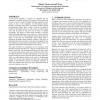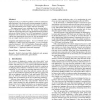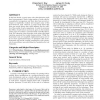31 search results - page 4 / 7 » Detection and analysis of near-miss software clones |
113
click to vote
ACMSE
2006
ACM
15 years 1 months ago
2006
ACM
A code clone represents a sequence of statements that are duplicated in multiple locations of a program. Clones often arise in source code as a result of multiple cut/paste operat...
PEPM
2010
ACM
15 years 8 months ago
2010
ACM
Duplicated code is a well known problem in software maintenance and refactoring. Code clones tend to increase program size and several studies have shown that duplicated code make...
C3S2E
2008
ACM
15 years 1 months ago
2008
ACM
In the last decade, a great many code clone detection tools have been proposed. Such a large number of tools calls for a quantitative comparison, and there have been several attem...
100
click to vote
SE
2008
15 years 1 months ago
2008
Existing software systems contain a significant amount of duplicated code. Such redundancy can negatively impact program correctness, since inconsistent updates to duplicated code ...
DAGSTUHL
2006
15 years 1 months ago
2006
Abstract. An original method of spectral similarity analysis for plagiarism detection in university project is presented. The approach is based on a clone detection tool called CLA...



